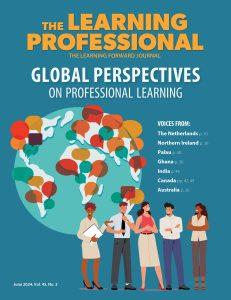Like all educators, I see the reports coming out about the scale of “unfinished learning” and it makes my heart hurt – for the students who didn’t get the opportunity to complete the learning they typically would have if not for the pandemic, and for leaders grappling with how to best design interventions for equitable learning recovery across a system. Last month’s National Assessment of Educational Progress student achievement report painted a startling picture of decline, and even more so for Black and Brown students and for those already struggling academically. When NAEP was released, Learning Forward offered up a collection of research demonstrating that high-quality professional learning is essential for building educators’ capacity to understand and meet each student’s needs – academic, social, and emotional. Professional learning is a core strategy for improvement.
I know system leaders and building administrators are operating with a high sense of urgency to move the needle on student learning acceleration, and many are looking to their professional learning communities or learning teams that are already established as one resource to help assess pandemic-related student learning gaps within a larger framework. Effective learning teams protect time for educators to be able to learn in collaboration with colleagues; collective efficacy has been shown to be among the top factors that influence student achievement.
But I am hearing frustration that learning teams right now aren’t making the kind of progress they want to be making. Learning teams are stuck – bogged down analyzing data, attempting to understand where the student learning gaps are so they can design for remediation. The hope is that the data will reveal the plan for “fixing” the student learning that didn’t happen in 2020 and 2021.
This is a learning crisis of such magnitude and complexity that we really do not have the luxury of looking backward to remediate our way out of it. Let’s center the challenge in professional learning as the driver to help us manifest our vision for learning acceleration.
Let's center this challenge in educator professional learning as the driver to help us manifest our vision for student learning acceleration. Share on XLearning teams can be a part of a holistic, proactive approach to accelerating learning. Professional learning communities can help create the conditions that will get students working at grade level, designing instructional strategies as well as plans for other needs. Administrators need to be supported to have the knowledge and skills they need, however, to help develop their learning teams to become the proactive drivers of the learning improvements they want to achieve. When professional development utilizes effective collaborative structures for teachers to problem-solve and learn together, it can positively contribute to student achievement (Learning Policy Institute 2017).
Administrators need to understand the value and importance of collaborative learning to improve teaching and learning. They need to know the role of learning teams in implementing high-quality instructional materials and what that means for student and educator learning goals and agendas. And, educators likely need instruction on how to collaborate productively within a learning team structure. Knowing how to facilitate or coach into the team dynamics is a learned skill. So is facilitating productive conflict.
When Learning Forward designs supports for administrators in learning team implementation and scaling, we engage learners in the Becoming a Learning Team framework for implementing teacher-led, team-based learning across all subject areas and grade levels in the school. Learning is grounded in Learning Forward’s Standards for Professional Learning, and focuses on implementing a five-step process of improvement that guides educators to:
- Engage in a process of data analysis to identify their most important student learning needs;
- Craft learning goals for their students as well as planning intentionally for their own learning to reach those goals;
- Choose learning designs that will help their teams achieve their individual, team, and campus goals;
- Implement new instructional strategies intentionally with planning, practice, reflection, and feedback;
- Monitor, assess, and adjust their instructional practice.
Implementation of these five steps allows team attention to focus on collaboratively studying grade-level standards and planning for the needs of all learners (both students and educators), as well as team planning of the formative assessments necessary for classroom instruction to be highly responsive to student learning, thus lifting the level of all teammates’ instruction and increasing the effectiveness and equity of original instruction.
By emphasizing use of the collaborative structure to predict, plan, implement new teaching behaviors, and monitor student progress, attention can be shifted from a reactive focus on student deficits to proactive planning of high-quality original instruction that considers and responds to the needs of all learners.
I am thinking about a recent coaching conversation where I was talking the teacher through her planning. She had a strong lesson plan, but as I am coaching, I am asking her to think, What are the gaps? What are the misconceptions that could emerge while you’re teaching this? How will you recognize which students are developing them, and what can you do about it now, as opposed to waiting until the students take a quiz? How will you recognize when this is forming in a student’s mind as it’s forming? What will you hear and what will you see them do that will tell you that it needs to be addressed?
As you can see, in instructional coaching, we are working to improve instruction, and also to move teachers to being more present and responsive during instruction. And that requires team support.
Education Secretary Miguel Cardona recently told a Harvard Graduate School of Education audience that the pandemic deepened the inequities in education that have been normalized over decades. The Oct. 24 NAEP student achievement data will bear that out, he said.
We need highly functioning PLCs because evidence demonstrates they result in stronger teaching for all students. Everything we know says teachers need common conference periods and time to collaborate. Let’s make sure they have collaborative learning time with their peers to solve student learning challenges.







